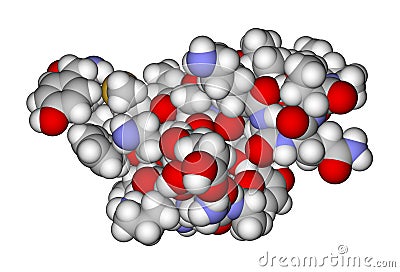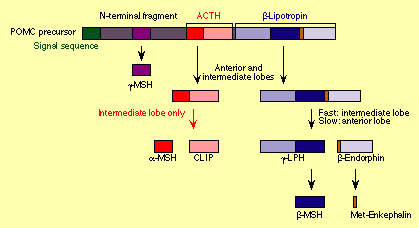Description
In this report I want to show the correlation between physical exercise and endorphins release, particularly in the phenomenon of "runner's high", which is a kind of addiction to sport.
Introduction
The discovery of endogenous opiates in 1975 generated considerable research concerning the effects of exercise on the release of these peptides, particularly on β-endorphin.
β-endorphin is an endogenous opioid peptide neurotransmitter 31 amino acids long. Endorphins are released from the pituitary gland into the circulatory system. Neurons producing endorphins are located mainly in the ventromedial arcuate nucleus, which projects to the hypothalamus and limbic system.

Synthesis
β-endorphin derives from proopiomelanocortin (POMC). Pro-opiomelanocortin (POMC) is a precursor polypeptide with 241 amino acid residues. POMC is synthesized from the 285-amino-acid-long polypeptide precursor pre-pro-opiomelanocortin (pre-POMC), by the removal of a 44-amino-acid-long signal peptide sequence during translation. The POMC gene is expressed in both the anterior and intermediate lobes of the pituitary gland. The protein undergoes cleavage processes by enzymes named prohormone convertase and the resulting hormones are:
• N-Terminal Peptide of Proopiomelanocortin (NPP, or pro-γ-MSH)
• γ-Melanotropin (γ-MSH)
• Corticotropin (Adrenocorticotropic Hormone, or ACTH)
• α-Melanotropin (α-Melanocyte-Stimulating Hormone, or α-MSH)
• Corticotropin-like Intermediate Peptide (CLIP)
• β-Lipotropin (β-LPH)
• Lipotropin Gamma (γ-LPH)
• β-Melanotropin (β-MSH)
• β-Endorphin
• [Met]Enkephalin
Since β-Endorphin and ACTH derive from the same precursor molecule and the secretion of both is stimulated by corticotropin-releasing factor (CRF), the diurnal rhythms of β-endorphin and cortisol are similar, as the secretion of cortisol is induced by increasing ACTH levels.

Mechanisms of action
Endorphins are part of a general class of hormones known as endogenous opioids. Opioid peptides activate three different types of receptors, mu (μ), kappa (κ), and delta (δ) receptors, all of which act through a second messenger. The affinity with which each opioid binds to the three different receptors can vary; endorphins primarily operate via the μ-opioid receptor. This receptor is known to mediate analgesic effects as well as play a role in the reward system within the brain.
Wikipedia
Endorphins, Exercise, and Addictions: A Review of Exercise Dependence, Andrea Leuenberger, Lafayette College, Easton
Endorphins and exercise
Many studies have tried to demonstrate a correlation between increased plasma levels of endorphins and exercise, but in some experiments endorphins levels were increased during physical activity and in some others they weren’t. However research has shown that opioidergic activity plays a role in addictions by mediating the development of reinforcing qualities of certain activities and substances. A newly established condition known as exercise dependence defines exercise as an addiction, characterized by a compulsion to exercise excessively even when the consequences are harmful to an individual’s health, family relationships, and personal wealth (Griffiths, 1997; Hausenblas and Downs, 2002; Loumidis and Wells, 1998). Endorphins are often implicated in the euphoria known as “runner’s high”, the relaxed psychological state sometimes experienced during or after vigorous exercise such as running. The "runner’s high" is said to be experienced by 60-70% of well conditioned runners.
Inconsistent evidence for a significant rise in endorphin release, however, makes it very difficult to simply deduce that endorphins released due to exercise are the cause of euphoric feelings. Similar to the euphoria data, results from studies on pain reduction are also conflicting due to inconsistent experimental methods and results. In one study, subjects who ran 1.6 km at a self-selected pace took significantly longer to report pain on their fingertip from a 1.2-kg weight. The analgesia, however, was reduced when a 2-mg dose of naloxone was administered; a 10-mg dose of the drug eliminated the analgesic effects altogether. This indicates that the endorphins released as a result of running could be responsible for the reduced pain sensitivity. Endorphins, Exercise, and Addictions: A Review of Exercise Dependence, Andrea Leuenberger, Lafayette College, Easton

Endorphins and Exercise, Victoria J. Harber, Dr John R. Sutton, Department of Medicine, MacMaster University, Hamilton, Ontario
Exercise and Endogenous Opiates, Tim Meyer, MD, Lothar Schwarz, MD, and Wilfried Kindermann, MD, PHD
Addiction
Multiple reports of exercise-dependence in humans have been documented, many in the form of case studies. People “exercise-addicted” all show a similar behavior: they manage to dominate their sense of hunger, physical fatigue and pain. They refuse the idea of being ill or weak and also show emotional instability with episodes of both depression and euphoria.
In one instance, a 25-year old female who participated in Jiu-Jitsu as her preferred form of exercise, reported having symptoms of tolerance, withdrawal, loss of control, relapse, and euphoria as a result of her excessive exercise. In addition to spending an unreasonable amount of money to maintain her habit, friend and family relationships were strained to the point of non-existence. Seeking exercise as a means to alter mood state, especially to experience a euphoric “high” or “buzz,” which many habitual exercisers describe as a motivation to exercise, can be labeled as an addictive behavior. Pierce et al. (1993) claim that endorphins have shown the ability to create addictive behavioral tendencies in individuals. However, their study (which did demonstrate an increase in endorphin levels after high-intensity aerobics) did not find a significant relationship between endorphin increase and exercise dependence. These results were based on an exercise-dependence survey taken before the exercise.
Animal studies have been more effective in finding a link between endorphins produced during exercise and dependence. Studies of opiate binding in the brains of mice who were exposed to warm water swimming found the antinociception (the inability to experience pain) from exercising to be correlated with an increase in endogenous opiate binding. Behavior of the mice after chronic exposure to the warm water swimming and subsequent abstinence from the activity was similar to that of morphine withdrawal. This indicates a dependence on exercise as a result of opioid activity. High-Intensity Extended Swimming Exercise Reduces Pain-Related Behavior in Mice: Involvement of Endogenous Opioids and the Serotonergic System,2010
To provide consistency in human studies, questionnaires and inventories have been created to qualitatively measure exercise dependence. The validation and use of such questionnaires can provide further insights about whether a dependence on exercise exists and in what types of people. Researchers could use these questionnaires to determine how these behaviors affect the well-being of “exercise addicts” and whether or not they are harmful.
Endorphins, Exercise, and Addictions: A Review of Exercise Dependence, Andrea Leuenberger, Lafayette College, Easton
Exercise Addiction- Diagnosis, Bio-Psychological Mechanisms and Treatment Issues, 2013 Pubmed
Conclusion
Although the relationship between endorphins levels and exercise is still unclear there are various evidences that endorphins are responsible for the sense of euphoria during physical activities and can also lead to an addiction to exercise in some individuals.